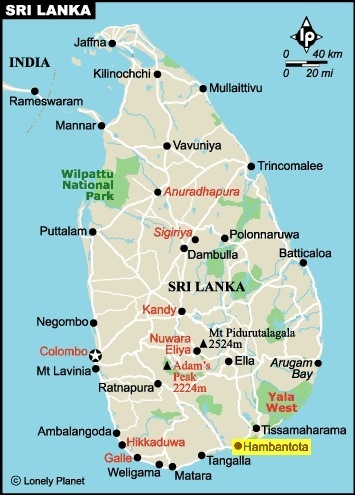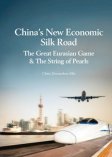China’s Belt and Road Initiative is Being Blamed for Sri Lanka’s Hambantota Port Problems. But the Real Story is Rather Different.


There has been a lot of media coverage recently about China’s Belt and Road Initiative creating debt problems in some of the countries aligned with the project. Often touted as an example is Sri Lanka’s Hambantota Port project, an apparent white elephant comprising both a brand new, yet under utilized airport, and a massive seaport that cannot handle the largest container ships. The development of these, say critics, is an example of how China has built infrastructure under the auspices of the BRI and saddled nations, such as Sri Lanka, with crippling debt for projects that no one needs.
The truth concerning Hambantota is rather more complex, more to do with vote winning and Sri Lankan local politics than the Chinese recklessly lending money. I should know, after all I live just a 30 minutes drive away from Hambantota and maintain a large property, where I reside in the winter, near Galle, just further west along the coast.
Hambantota has long been part of the development plans for Sri Lanka, and especially so as its southern and eastern coastal tourism industry has been developing. The two component parts – the airport and the port, serve different functions – the airport to provide better access to foreign visitors and tourists to the south-eastern coast of Sri Lanka, and the Port to facilitate commercial shipping on its east coast. Currently, the main Colombo airport is on the West coast, as is the main Colombo Port, facing India. In terms of flights, having an airport at Hambantota would cut 30 minutes flying time off flights arriving from Asia, and an additional three hours drive to reach the southern coast beach resorts – and five hours if travelling on safari to Yala, one of the country’s largest and most popular national parks. Developing an airport on Sri Lanka’s south-eastern coast therefore makes a lot of sense – if only the political will – and finance – could be obtained.
 The Hambantota Port, however, is a different matter. It has long shown location potential, only for specific localized geophysical features to render it unsuitable for development. Other experts, including a Japanese consortium, have explored the concept of developing Hambantota Port, only to conclude that it remains technically difficult to develop. A Chinese consortium disagreed, and deigned to take on the project.
The Hambantota Port, however, is a different matter. It has long shown location potential, only for specific localized geophysical features to render it unsuitable for development. Other experts, including a Japanese consortium, have explored the concept of developing Hambantota Port, only to conclude that it remains technically difficult to develop. A Chinese consortium disagreed, and deigned to take on the project.
At this point, Sri Lankan politics comes into play. That region is where the previous President of Sri Lanka, Mahindra Rajapaksa, was born, and his family still resides. Rajapaksa is both revered and loathed in equal measure in the country, admired for his role in ending the civil war that had gone on for over 30 years, but also distrusted for what began to be seen as excessive alleged corruption and cronyism in the dispersal of State assets. Rajapaksa, however, had been able to unite aspects of what had, up until the end of the war, been a divided country, and that included political factions. In short, he got things done, and that included building and completing the Hambantota airport, which he promptly named after himself.
Rumors, however, of collusion with China, and the self-lining of pockets by family members placed into prominent political positions began to hound him, and he was unexpectedly voted out of office in the Presidential elections in 2015. It is interesting to note that allegations of China’s lending of money at exorbitant rates for the development of Hambantota’s port and airport began at about that time. The newly sworn in President Maithripala Sirisena then delayed completion of connecting roads from the National Highway system to the new airport and essentially mothballed it. After all, it wouldn’t be politically seemly to open an airport everyone knew had been built by and named after your defeated main rival.
Accordingly, the fate of the Hambantota developments hangs largely under Rajapaksa’s remit, and not that of the Chinese. The airport has remained underused and underdeveloped as a result of Sri Lankan political jostling, not that of Chinese incurred debt. However, Rajapaksa’s political party, Podujama Peruma, won the national elections earlier this year by some considerable margin. It is extremely likely that the next Presidential elections, to be held in 2020 would see Rajapaksa returned. It is also likely he will return to the spotlight the Hambantota project that bears his name and see it put to good use.
This means that although there has been discontent in Sri Lanka concerning the Hambantota projects, the reasons for their dysfunctional status are more to do with local politics than Chinese debt financing.
What has instead been a bone of contention with China was the decision to lease Hambantota Port development to the Chinese for a period of 99 years. and the further development of the Colombo Port City, a massive redevelopment of Colombo’s port on the West coast. That has lead to accusations of Sri Lanka selling off land to the Chinese in order to service debt. But it works both ways – China built and paid for the projects, Sri Lanka consequently awarded them the service contract. Without them, the region would remain undeveloped and the entire tourism infrastructure of southern Sri Lanka would be retarded.
Looking at the debt/lease issue in Sri Lanka as just one aspect to criticize China’s Belt and Road Initiative is a therefore rather short sighted. Sure, China built the infrastructure and Sri Lanka leased the port to the Chinese for 99 years. But I suspect that the development of Sri Lanka’s tourism, hospitality and related industry developments will rather more than offset the cost of giving China control of the port and the profits that arise from that. After all, with property in that region, I’m looking at a rather large increase in the value of my own assets because of the airport, and especially so when it eventually gets up to speed. The trends are there. Tourist numbers are increasing on a massive scale. This graph just shows the Chinese figures.

China’s infrastructure development in Sri Lanka may not have planned out as smoothly as it could have done. But that is the risk for China in developing in democratic countries, as local politics can and do get in the way just as they did in Hambantota. But that is a different thing from suggesting the infrastructure investment is loading the nation up with debt. It isn’t, and the developments will come good. The critics may like to look at the underlying local politics, rather than Chinese financing, as the bottlenecks that can get in the way. Hambantota has been a classic example – and one that will almost certainly still come good. It is certainly not an example of either China loading up countries with unserviceable debt, nor of building white elephants. Hambantota is an infrastructure project whose time will come, and whose delays have been due to local, not Chinese politics.
About Us
Silk Road Briefing is produced by Dezan Shira & Associates. The firm provides business intelligence, investment advisory, due diligence, tax advisory, corporate establishment and structuring, accounting, payroll and related professional services throughout China, India, ASEAN, Russia and the Eurasian region, servicing both Governments and Multinational clients. To contact us please email silkroad@dezshira.com or visit us at www.dezshira.com
 Related Reading:
Related Reading:
Silk Road and OBOR Business Intelligence
Dezan Shira & Associates´ Silk Road and OBOR investment brochure offers an introduction to the region and an overview of the services provided by the firm. It is Dezan Shira´s mission to guide investors through the Silk Road´s complex regulatory environment and assist with all aspects of establishing, maintaining and growing business operations in the region.
China’s New Economic Silk Road
This unique and currently only available study into the proposed Silk Road Economic Belt examines the institutional, financial and infrastructure projects that are currently underway and in the planning stage across the entire region. Covering over 60 countries, this book explores the regional reforms, potential problems, opportunities and longer term impact that the Silk Road will have upon Asia, Africa, the Middle East, Europe and the United States.







